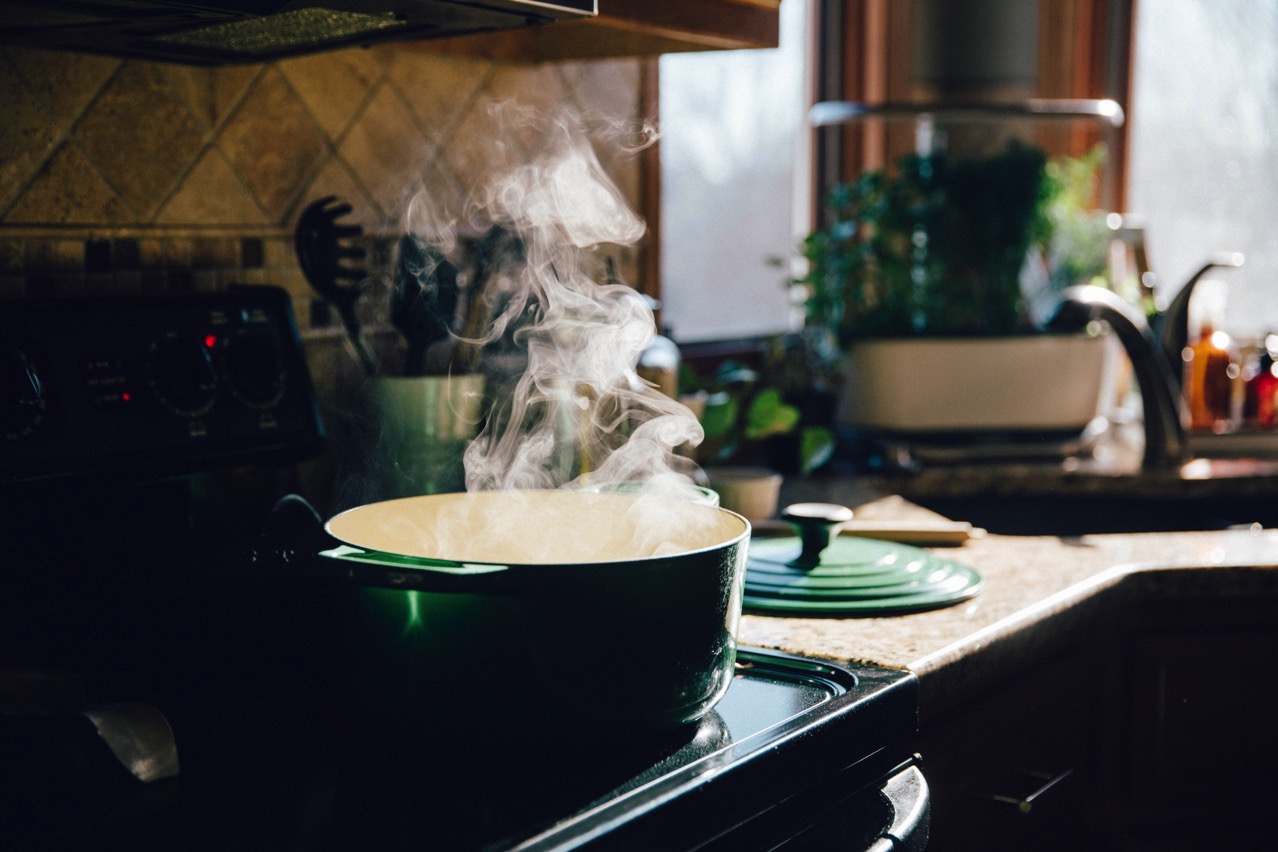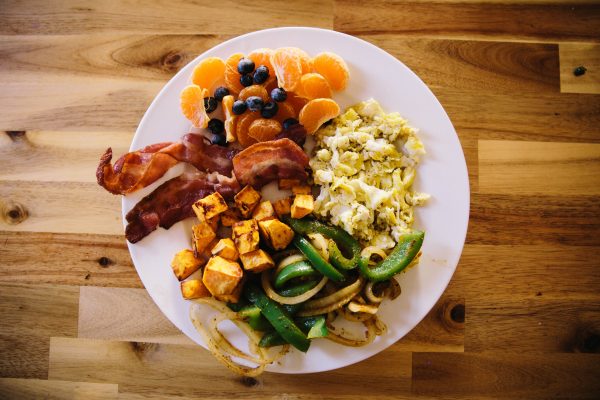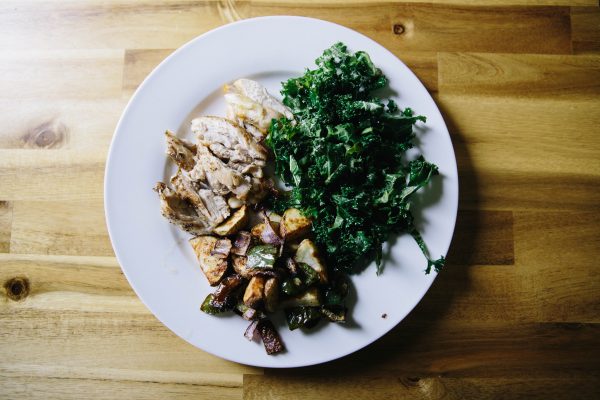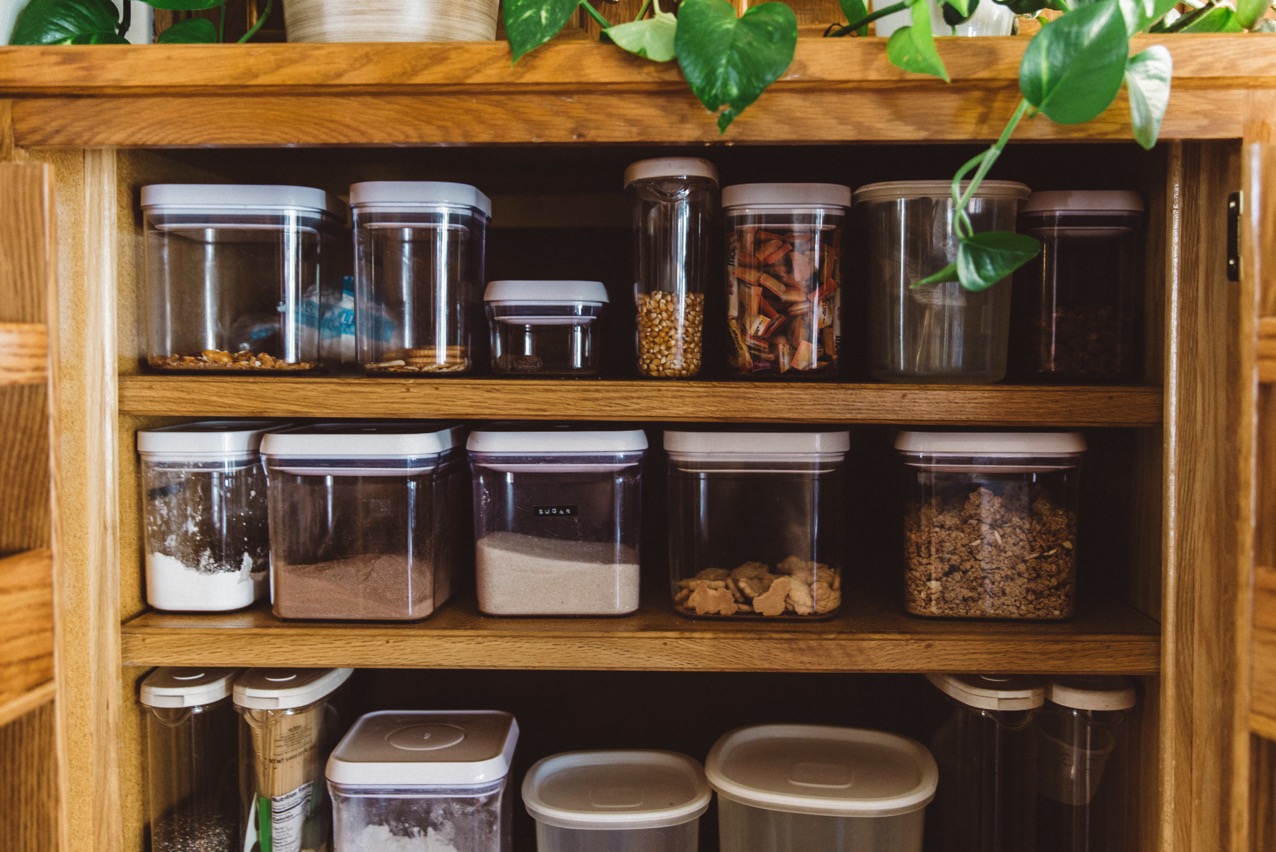“I just ate six oreos and a huge scoop of ice cream; I don’t know why I did that!” This was the desperate text I sent my holistic fitness coach after a particularly trying day just before my period.
I waited for the hammer to drop.
A few minutes later my phone pinged.
“Oh, it’s because you didn’t eat enough protein.”
Wait, was that it? I didn’t eat enough? This was not the first time I’d hear Evgeniia tell me I needed to eat more food.

Getting to Burn Out
Before I started working with Evgeniia in her Nourished Motherhood program in October I was on the edge of burn-out in the most stressful season of my adult life. Two months prior, we had just moved to a house under partial construction after two years of living in a rental house in Kansas. During those two years we were trying to decide where to land for the next season of life. The possibility that we’d move back to our home in California was alive in my mind for a long time. As we moved boxes and painted trim in our new house, the reality that we weren’t going back hit me with grief I wasn’t prepared for.
I started waking up between 1 and 3 am with my mind racing, unable to fall asleep for hours. I was so anxious that I could wake up at 1 am and go the entire day running on nervous energy.
About one month later I was shocked to find out that I was pregnant. Now the insomnia was happening even more regularly as I tried to wrap my mind around the logistics of bringing another little person into our family by my fortieth birthday.
When I learned about the Nourished Motherhood program, I knew I needed to do it. I simply knew too many other mamas in my stage of life who were entering burn-out with adrenal fatigue, insomnia, and hormone imbalances. I wanted to do something before I reached that point.
Starting the Nourished Motherhood Program
The Nourished Motherhood program started out with gentle changes instead of restriction. The first thing Evgeniia did was get me drinking a glass of room temperature water and bone broth in the morning. This immediately helped balance my blood sugar and reduce my cravings. Next, I got on a consistent walking routine. I’ve always loved to walk, so I was excited to hear this was part of my health plan.

She also had me eat a protein-filled breakfast an hour after waking and add veggies to all my meals (this took time for me, breakfast-wise.) I practiced making a plate and sitting down (you don’t know how hard this is till you’ve been a mom), chewing my food and eating slowly to signal my digestion. Snacks and meals were served on a plate sitting down comfortably at the table. Eating protein and whole foods that fulfilled me were the only rules.
Two days a week I did a strength training work out using an app called Trainerize. I also learned how to breathe and stand in order to repair my core.
I did a big thing and stopped drinking caffeine. I never thought I’d be able to do this, but when it came to coffee and sleep, I wanted sleep more! This stopped the middle-of-the-night insomnia and revealed a calmer me. If you struggle with anxiety or insomnia, I’d make quitting caffeine my first stop.
Since I know you’ll ask–I had a three day withdrawal that really wasn’t that bad. At first I replaced my coffee with matcha and Dandy Blend tea (matcha has a slow release caffeine). I like them but I really just love the taste and smell of black coffee. I drink decaf coffee right now and it hasn’t had any negative effects so far.
My Rollercoaster Diet History
To understand the shifts that I’ve made in the last six months, we need talk about my dieting history for a minute (maybe you have one too). I had never carried extra weight until I got pregnant at twenty-eight with my first baby and gained 65 pounds. It was a huge shock. I lost that weight from my first pregnancy within six months by just barely eating anything.
Thankfully the home birth community taught me how get off processed foods and how to enjoy the benefits of whole organic foods, which I incorporated that first year of being a mom. I quit drinking soda, Diet Coke and fake sweeteners (though it took me a year to fully quit Diet Coke.) During this season of my life I made major changes to my way of eating that stuck, which I’m proud of.
For each and every baby after that, I always gained up to the exact same weight just before giving birth (201 pounds, in case you wondered). It happened that way even though I was a different starting weight each time.
Every postpartum period, I dealt with body shame. Even with my knowledge about not eating “diet” and processed foods, I still wanted a quick fix. I would race to frantically lose the 50 pounds with some diet: Paleo, Weight Watchers, Keto, intermittent fasting. I read all the books and did all the things. I also worked out in different postpartum seasons, but never had been able to maintain a routine for more than six months at a time.
Lucky for me, I’m the kind of person who loses weight while breastfeeding, so that always worked in my favor. But as soon as I would wean a baby, I’d gain a good ten to twenty pounds back. Plus, when you do extreme diets, you starve yourself and end up binging on everything you never let yourself eat. Your body is in stress mode, especially if you have been breastfeeding and pregnant for years. Telling myself that foods like bananas had too much sugar or that good bread wasn’t allowed was the perfect recipe for the alarm bells of cravings to go off.
Birthing and nursing babies constantly over a ten-year period of time is a wild ride of unpredictability by itself. It’s not easy work. In our culture, women are expected to carry on and “bounce back” with little support. Even though I used dieting, I did the best I knew to do at that time and I’m proud of what my body was able to do in birth and breastfeeding.
The Mindset Shift that Changed Everything
No matter how much we want a pill or supplement, getting healthy starts with mindset. I had to deal with what was happening on the inside of me before real change could happen on the outside.
When I got pregnant the fifth time, I was dreading the rollercoaster of jean sizes and cutting carbs. What I wasn’t prepared for was the rollercoaster of miscarriage. Our baby’s heartbeat stopped at 10.5 weeks and I miscarried at 12 weeks. We lost our baby in November of 2022. During this time Evgeniia stayed with me checking in with me as I recovered, helping me ease back into an exercise and eating routine. I had a support that I didn’t know I would need.
We did lots of mindset work in this journey. I journal each day, say Biblical affirmations (I got my cards from Daily Grace Co), meditate, and pray. This is so important because it’s difficult to connect with yourself and identify the mindsets you need to change without this type of regular reflection.

After about five months of this kind of self-care, I had a major revelation about why I was stuck in a cycle of dieting: I actually didn’t think I deserved to take care of myself until I had reached a certain size. I had a subconscious soundtrack in my head that said “I will take care of myself, but first I have to lose this weight.” It had to be weight loss first, no matter what extreme or unhealthy measure it took.
In other words, I need to punish myself and prove my worth through body size before I can treat myself well.
Maybe you know this story too.
My struggle was never about my lack of “willpower” or inability to “be good.” (Heck I had willpower–I had been cutting carbs for ten years!) It was about seeing my own worth enough to say “You’ll have to wait for me while I finish my snack” or “You can play next to me while I do my work out” or “I need to buy a weights bench.”
A big part of seeing my own worth was to stop being afraid to inconvenience my family with my own needs. For example, saying “I ran out of produce and I need to run to the store” or ordering the more expensive thing on the menu because it’s more nourishing–those were things I was afraid to do. Even with all my knowledge about healthful eating, I was needing to grab highly processed foods because I was waiting too long to feed myself or simply didn’t feel like I had permission to make a bowl of berries with nuts and sit down to eat it in a way that felt satisfying. These were things that I saw my healthy friends doing that I secretly wanted to do for myself, but didn’t think I could.
I know this is really hard to do as a mama, especially if you’re with your children all day homeschooling. There’s no one around that’s going to tell us to take an epsom salt bath or cut up an apple and deliver it to us in a ramekin with almond butter. We have to learn how to do this ourselves because although it seems counterintuitive, our families need us too. Yes, they want a spoon for their applesauce and help putting their shoes on right now this very second. But they also want us to be there for them ten, twenty and thirty years from now.
I know that if I end up sick one day with adrenal fatigue or some stress-related illness, I will be forced to make these lifestyle changes anyways. And I will have to do it in a much more difficult circumstance. My family may be inconvenienced by my needs in a far greater way. Why wouldn’t I just do it now? This was a question I had to answer every time I became anxious about taking time to cut up extra veggies or put the healthy bread in my grocery cart.

There can be lots of reasons why we have knowledge about what’s healthy but continue to do things that are not good for us. Sometimes we are holding on to grief or trauma that we haven’t processed. Or maybe we grew up in a home where there was food scarcity (diet culture at home is part of this too!) Often we are punishing ourselves because the places where we store healthy body fat don’t look like the influencer on Instagram. Maybe like me your “rescuer” codependency traits come out in your resolve to never need anything from anyone.
Sometimes I’m just plain tired from taking care of everyone else all day! (Sometimes it’s just not that deep.)
I also grew up being trained to be grateful for the food that was given to us when visiting friends or family. Rejecting someone’s gift of food is very hard for me. I’m from a big family who loves to gather and cook together, so celebrations that center on food are also a mental-emotional hurdle for me.
Non Scale Victories
While the scale stayed the same, my body started to look different. (And I could sleep.) I had so many non-scale victories that fueled me to keep going. I stopped being bloated and started having regular bowel movements (always a challenge for me!) I started to have pain-free periods! (This is the best.) Sitting down to a lunch break and taking time to stretch and exercise became like any other part of my life. I don’t have blood sugar crashes after meals or in the afternoon. ‘
Non scale victories really helped me put weight loss into it’s right place.

This method of filling my plate helped me get into a routine that’s not a diet, but a framework to help me nourish myself. When I make a plate, I start with one serving of protein, one serving of fat and a starchy carb of choice. Then I aim to fill the other half of the plate with vegetables. I always eat the most at breakfast time. This makes an unbelievably huge plate of food. I never feel like I’m missing out on anything!
My tendency is to want to skip regular food to “make up for” eating treats, but I’m learning not to do that.
I also have snacks: one in the morning and another in the afternoon. I’m eating for energy so my first snack is always fruit-based with a fat or protein. (And if I want chocolate or a cookie, I have it here!) Afternoon is veggie time. I have a bunch of raw veggies with hummus and usually something savory like almond flour crackers.
Changes on the Scale
Can you lose weight eating that much food? I wondered the same thing. Evgeniia said that I could count calories temporarily if I wanted help gauging what I was eating. After only a few days of tracking, I was surprised when I realized that if I used this full plate method consistently, I would be eating the right amount of calories for my body to come back into balance with weight.
Counting the calories also helped me to see that I was not that far off track–I was just using a few more servings of fats than what I needed and probably taking too many mindless bites while prepping food for my family. Any time I neglect myself through skipping a snack or waiting too late to eat a meal, I will assuredly go looking for something with high caloric density and little nourishment.

You might want to know if I’ve lost any weight. Well, after my miscarriage, I was near my heaviest weight and it stayed the same for a long time. After six months of making big changes, my body was ready to release weight and the scale is starting to move.
I don’t know what will happen on the scale long-term. If I’m honest, I would love to lose 20-30 pounds but I won’t sacrifice my mental or physical health to do it. My ultimate goals are to have energy and be there for my family over the next forty years.
How I’m Exercising
What about exercise? Well, three times a week I do a twenty-ish minute circuit style work out using free weights and body weight exercises. The Trainerize app has videos that show you the exercise and sets a timer for each set. I usually rank them as a 7 or 8 on a difficulty scale. It turns out, I enjoy working out. I just don’t like doing at at a level 10 difficulty or being yelled at while I do it!
Over Christmas break, I spent a few weeks reorganizing my basement so that I could have a work out space. Our basement is unfinished and nothing fancy, but I laid down a big piece of carpet where I can store my bench and weights. (Yes, of course everyone thinks it’s an ideal place to play with all of their toys!)
I like working out at home because I can just run down in my sweats at any old time that works for me. I walk about twenty to thirty minutes every day. David mowed me a path through the back section of our property that I can walk while the kids are watching a show inside. Sometimes it’s really cold or wet and I have to walk on the driveway, but it’s always a pleasant time where I can listen to a podcast or talk to my sister. I’m proud of myself that I overcame the mental barrier of walking outdoors even in a Midwest winter (Evgeniia is from Canada and walks outside all winter, so I didn’t have a lot of excuses!)

Where I’m at Now
When I wrote this post, I had to think hard about all the micro changes I made over the last six months! It happened very gradually with lots of falling off and getting back on, so I can’t point to one thing that changed overnight.
I still love a square of dark chocolate or an Unreal bar after lunch and I sometimes wonder if I’ll ever not want it. But I know that the more I eat to feel good, the more I feel the contrast when I eat a brownie and it sits in my stomach like a rock for two hours. I’m also re-learning where and how I can eat out, especially on date nights.
Maybe you are wondering if this is something you can do too. It absolutely is. You just have to be willing to ask yourself bold questions and answer them honestly. It might take a few times of eating six oreos and a scoop of ice cream at 2pm on a Wednesday without knowing why before you do know why.

I know that as a woman, my body will be changing my whole life so I know I can’t tie my worth to whatever my body is doing at this moment.
In the end, it doesn’t matter how many pounds away I am from my college or high school weight. I have no one to impress on Facebook; just a family that loves me and wants me around for a long time. I know that I will continue to take care of myself no matter what my body size is–and that’s a beautiful place to be.
I hope I’ll be back here in six more months to share more victories and mindset shifts! You can also find Evgeniia here on Instagram with helpful tips and encouragement for the homeschool mama, or here at her Nourished Motherhood coaching program.